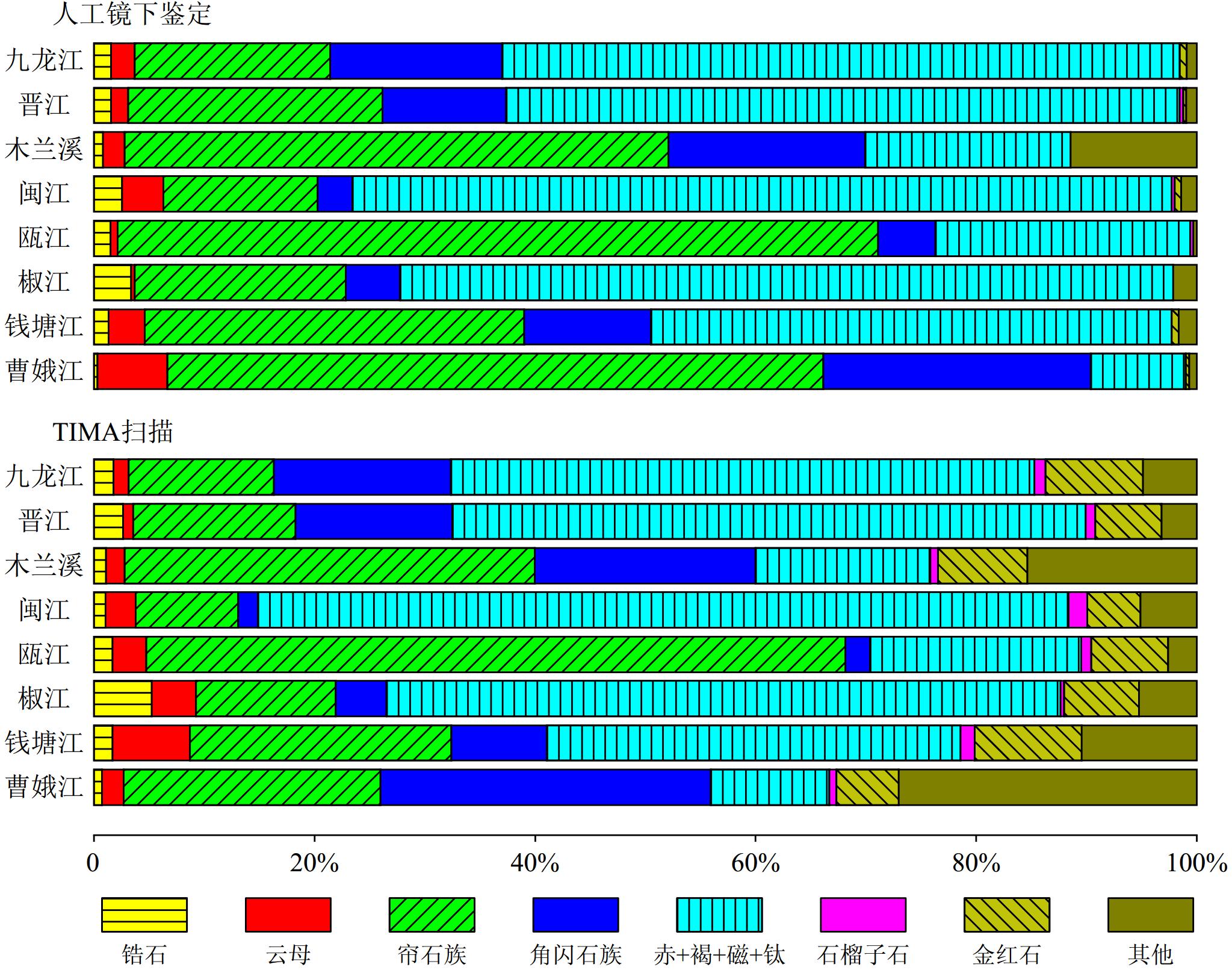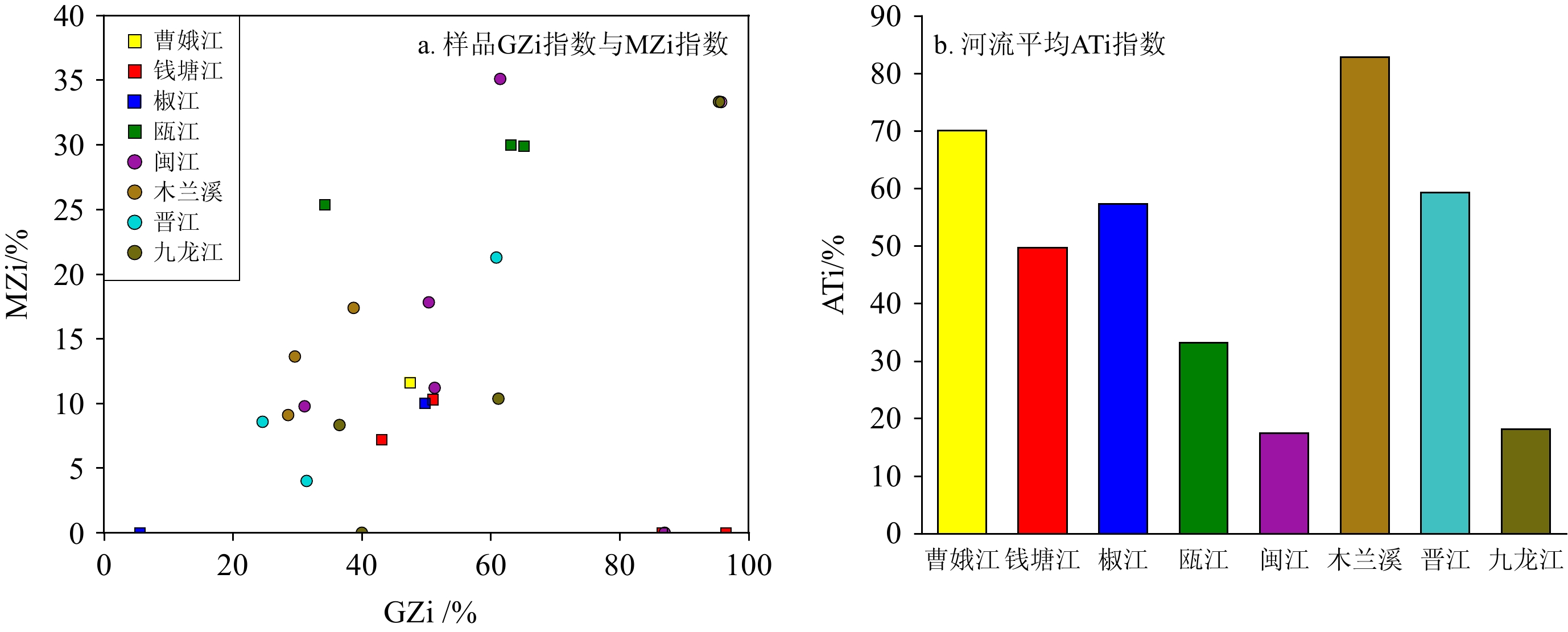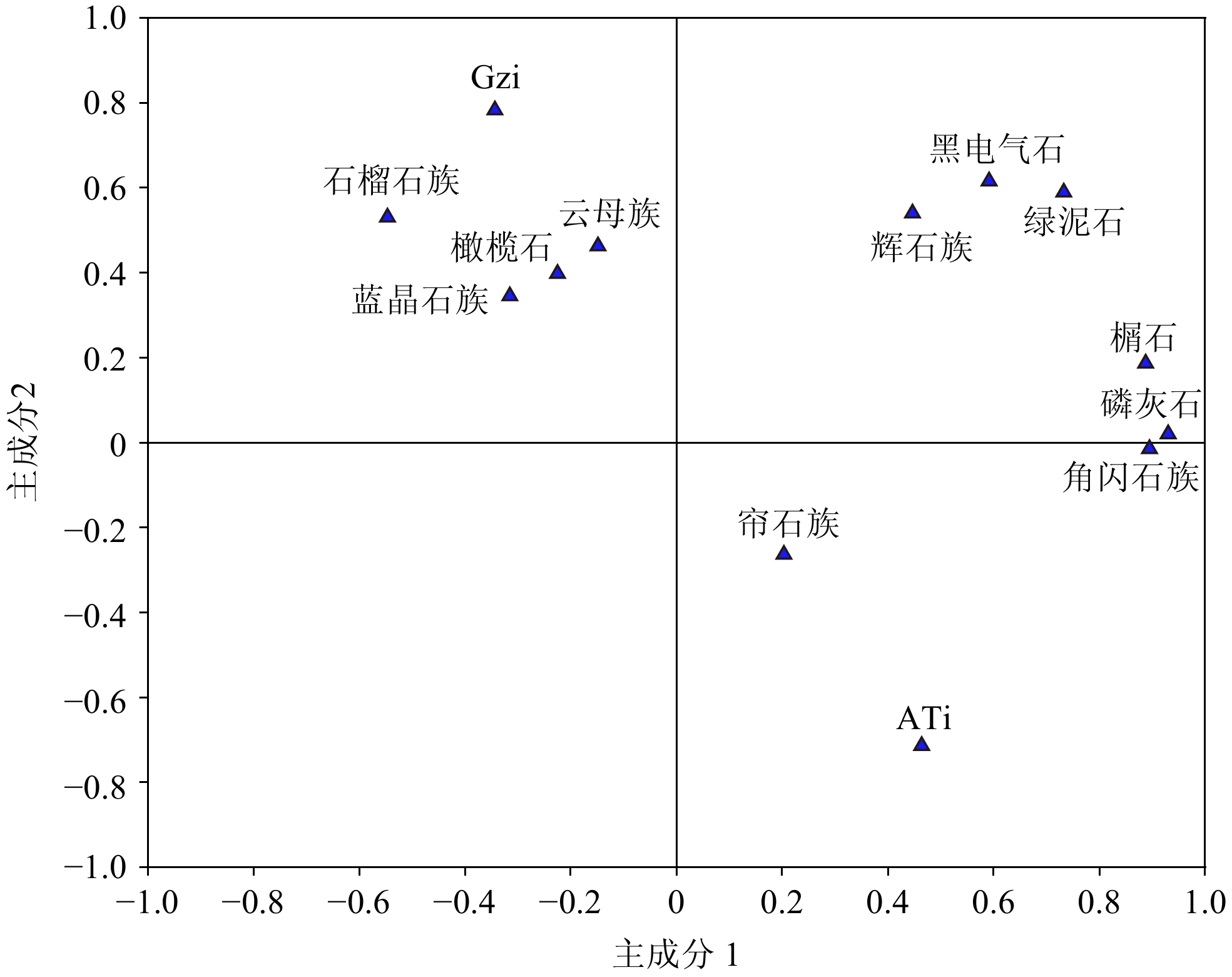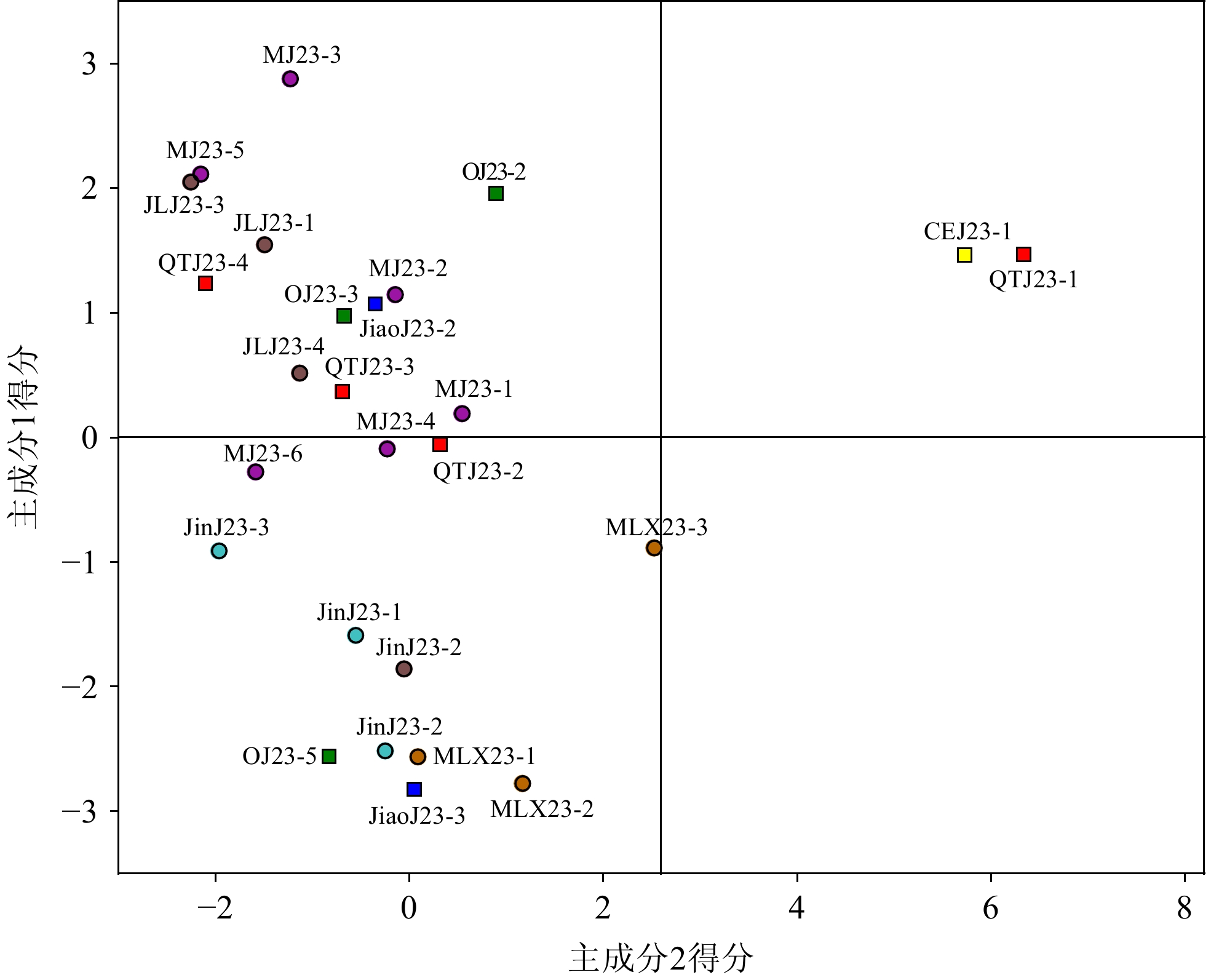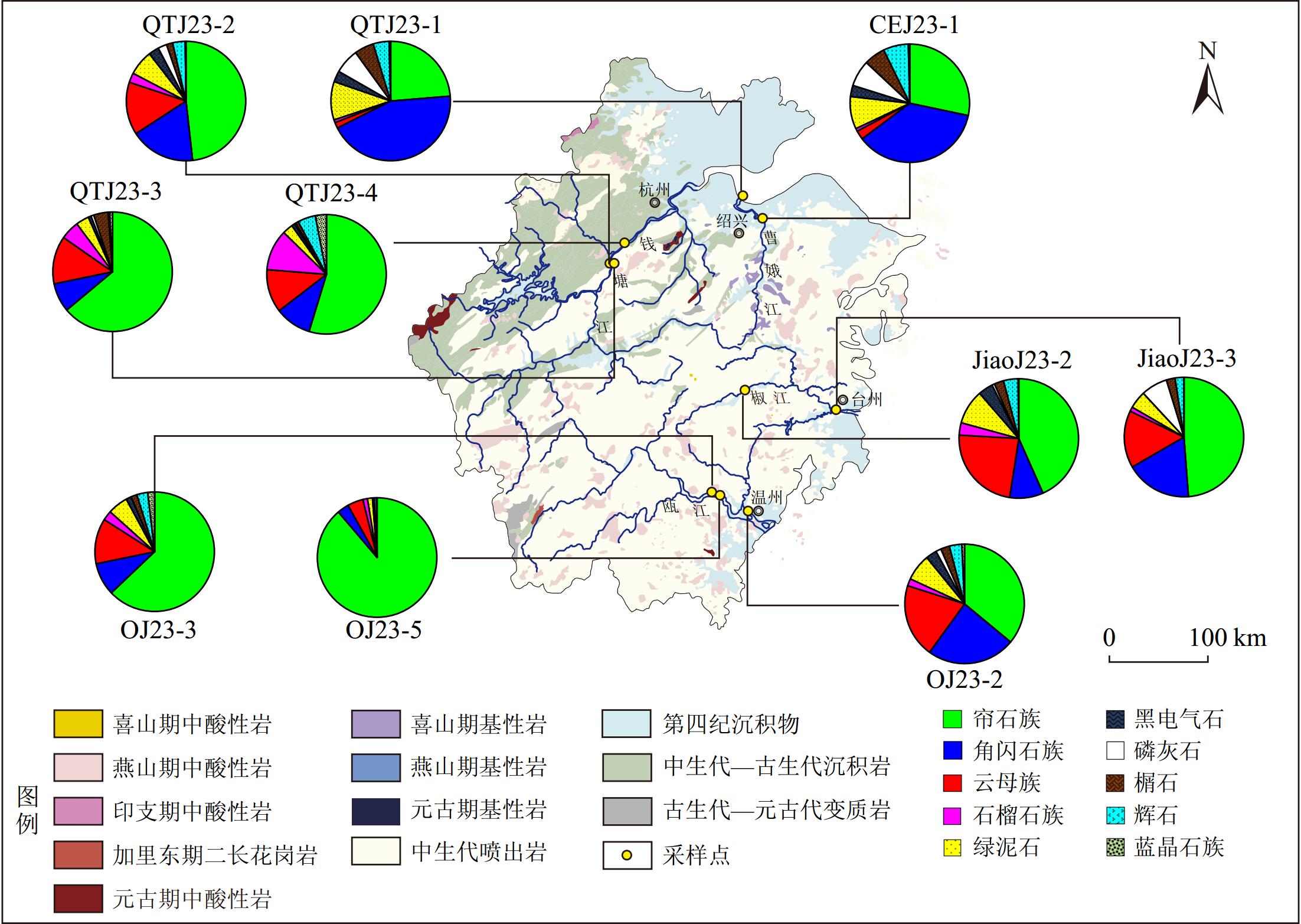Automatic identification of heavy mineral compositions in Zhejiang-Fujian rivers and implications for provenance analysis
-
摘要:
沉积物重矿物组成分析是开展物源分析的重要手段之一。然而,常规重矿物人工鉴定存在误差大、统计量小、重复性差等问题,在如何通过重矿物组成揭示物源特征和示踪沉积物源汇过程等方面还具有很大挑战。通过矿物自动定量分析技术TIMA(TESCAN Integrated Mineral Analyzer),本文对钱塘江、椒江、闽江等浙闽流域8条主要入海河流的26个沉积物样品进行了重矿物分析,通过对人工鉴定结果对比及流域地质背景的比较,探讨了TIMA重矿物分析在物源示踪方面的潜力。共分析了
209019 个矿物颗粒,区分出36种不同类型的重矿物。与人工鉴定方法比较,二者对河流主要重矿物类型及其相对含量变化的鉴定结果基本一致,但TIMA耗时更少,鉴别出的重矿物数量和类型更多,且鉴定结果重现性好。TIMA重矿物分析结果表明:浙闽流域主要的重矿物组合为帘石族、角闪石族与铁质金属矿物,其中,绿黝帘石占重矿物百分比高,是浙闽流域的典型重矿物;角闪石族矿物主要为普通角闪石,其次为铁阳起石,含量在不同流域样品间有显著差异;铁质金属矿物百分比在大部分样品中大于40%,含有赤铁矿、磁铁矿、褐铁矿、钛铁矿与自生黄铁矿等矿物。整体上,浙西北、浙东南与闽西北、闽西南、闽东地区出露地层岩性的差异决定了浙闽河流重矿物组成的特征差异。主成分分析表明,磷灰石、角闪石族和榍石的较高正载荷(>0.88)与主成分1相关,指示了主成分1受岩浆岩源岩的控制;而主成分2与黑电气石、石榴石族和绿泥石的较高正载荷相关,代表了受变质岩源岩的影响。本研究表明,在对重矿物精确性要求较高的研究中利用TIMA等自动矿物识别方法对河流至海域的重矿物进行从源到汇的系统研究更为高效。Abstract:Heavy mineral composition in sediments is one of the primary analytical methods for provenance analysis. However, conventional manual identification of heavy minerals has problems such as large errors, small statistics, and poor repeatability, posing substantial challenges in revealing provenance characteristics and tracing sediment source and sink processes. Utilizing the TESCAN Integrated Mineral Analyzer (TIMA), we conducted heavy mineral analysis on 26 sediment samples from eight major coastal rivers in the Zhe-Min basin, including the Qiantang River, Jiaojiang River, Minjiang River, and so on. By comparing the results of manual identification and the geological background of the basin, the potential of TIMA heavy mineral analysis in provenance tracing was explored. A total of
209019 mineral grains were analyzed, and 36 different types of heavy minerals were distinguished. Compared with the manual identification methods, the identification results of the two methods for the main heavy mineral types and their relative content changes in the river are largely the same. However, TIMA takes less time, identifies more heavy minerals in quantity and types, and has good reproducibility of identification results. TIMA heavy mineral analysis results indicate that the main heavy mineral assemblages in the Zhe-Min basin included epidote group, amphibole group, and ferromagnetic metal minerals, of which zoisite is the predominant type and a typical heavy mineral of the basin. The amphibole group minerals are primarily composed of hornblende, followed by ferro-actinolite, with significant variations in content across different basin samples. The percentage of ferromagnetic metal minerals exceeds 40% in most samples, containing hematite, magnetite, limonite, titanium magnetite, and authigenic pyrite. Overall, the differences in exposed stratigraphic lithology in the northwestern Zhejiang, southeastern Zhejiang, northwestern Fujian, southwestern Fujian, and eastern Fujian areas reflect the distinct characteristics of the heavy mineral composition in Zhe-Min rivers. Principal component analysis showed that the higher positive loadings (>0.88) of apatite, amphibole group, and xenotime are associated with the principal component (PC) 1, suggesting that magmatic source rocks influenced the PC 1. Conversely, the higher positive loadings of schorl, garnet group, and chlorite associated with PC 2 indicate influence from metamorphic source rocks. This study demonstrates that it is more efficient to systematic research on heavy minerals from rivers to the sea using automated mineral identification methods like TIMA in the study of heavy minerals with high accuracy requirements. -

-
表 1 人工和TIMA鉴定重矿物颗粒数量的比较
Table 1. Comparison in the number of heavy mineral grains identified by manual and TIMA methods
河流 样品 位置 人工鉴定颗粒数/颗 TIMA扫描颗粒数/颗 曹娥江 CEJ23-1 29°57.264'N, 120°52.511'E 301 59688 钱塘江 QTJ23-1 30°13.405'N, 120°45.395'E 341 40209 QTJ23-2 29°43.998'N, 119°38.428'E 305 12239 QTJ23-3 29°44.351'N, 119°39.295'E 293 424 QTJ23-4 29°53.491'N, 119°48.483'E 117 1094 椒江 JiaoJ23-2 28°53.017'N, 120°56.138'E 306 8572 JiaoJ23-3 28°44.272'N, 121°19.346'E 324 324 瓯江 OJ23-2 27°58.969'N, 120°46.135'E 300 7743 OJ23-3 28°8.609'N, 120°22.837'E 302 1417 OJ23-5 28°8.170'N, 120°28.888'E 329 2934 闽江 MJ23-1 26°5.826'N, 119°32.270'E 300 19898 MJ23-2 26°2.872'N, 119°13.293'E 306 3915 MJ23-3 26°9.212'N, 119°6.442'E 269 999 MJ23-4 26°12.868'N, 119°2.915'E 320 956 MJ23-5 26°22.035'N, 118°43.739'E 337 981 MJ23-6 26°12.499'N, 119°2.468'E 356 3468 木兰溪 MLX23-1 25°22.429'N, 118°53.815'E 319 3069 MLX23-2 25°22.429'N, 118°53.815'E 309 6357 MLX23-3 25°24.363'N, 119°7.690'E 359 1726 晋江 JinJ23-1 24°51.075'N, 118°39.134'E 326 2291 JinJ23-2 25°50.700'N, 118°38.743'E 323 6849 JinJ23-3 24°57.220'N, 118°27.184'E 300 6220 九龙江 JLJ23-1 24°34.119'N, 117°43.455'E 323 12733 JLJ23-2 24°29.285'N, 117°42.714'E 332 1839 JLJ23-3 24°28.337'N, 117°48.507'E 165 2512 JLJ23-4 24°26.036'N, 117°54.534'E 118 562 表 1 人工鉴定浙闽主要入海河流重矿物颗粒百分含量
Table 1. Manual identification of the percentage of heavy mineral particles in the main rivers in Zhejiang-Fujian
% 矿物名称 CEJ23-
1QTJ23-
1QTJ23-
2QTJ23-
3QTJ23-
4JiaoJ23-
2JiaoJ23-
3OJ23-
2OJ23-
3OJ23-
5MJ23-
1MJ23-
2MJ23-
3MJ23-
4MJ23-
5MJ23-
6MLX23-
1MLX23-
2MLX23-
3JinJ23-
1JinJ23-
2JinJ23-
3JLJ23-
1JLJ23-
2JLJ23-
3JLJ23-
4绿帘石 59.5 12.0 34.4 20.1 24.0 19.1 19.1 41.8 43.3 69.0 42.0 19.0 32.6 40.7 18.4 14.0 25.9 65.4 49.3 26.4 23.1 36.5 25.5 17.7 18.5 17.2 角闪石 24.3 69.9 11.5 5.9 2.0 2.3 4.9 15.5 8.0 5.2 17.7 14.1 12.5 12.0 1.2 3.1 23.3 12.0 17.8 14.4 11.2 4.0 8.7 15.6 11.1 14.7 赤+褐+磁+钛 8.6 7.9 47.2 70.6 70.9 74.7 70.1 35.0 44.3 23.1 20.3 60.8 47.0 40.4 73.7 74.3 47.9 19.4 18.7 56.4 61.1 53.2 59.8 61.5 67.9 64.7 黄铁矿 − − − − − − 0 2.4 − − 13.0 − 0 − − − − 1.0 9.5 − − − − − − − 白钛石 − − 0.7 − − 0.7 1.9 − − − − − 1.1 − 1.2 − − − − 0.6 0.6 0.3 − − − − 锐钛矿 − − − − − − − − − − − − − − − 0.3 − − − − − − − − − − 黑云母 − 0.9 − − 0.5 1.0 − 0.7 1.3 − 0.3 0.7 1.5 1.9 0.6 0.6 0.9 − − 0.3 − 1.3 0 1.5 0.6 0.9 风化黑云母 6.3 7.6 3.3 1.7 0.5 0.3 0.3 4.0 2.0 0.6 3.7 3.9 2.7 3.2 3.6 3.1 0.9 1.3 1.9 0.6 1.6 2.0 3.7 0.6 1.2 2.6 白云母 − − − − − − − − 0.3 − − − − − − − − − − − − − − − − − 石榴石 − 0.1 − 0.7 0.5 − − − − 0.3 0.7 0.3 − − 0.3 0.3 0.3 − − − 0.3 0.3 0 − − − 电气石 0.7 1.5 0.3 − − − 0.3 − − − 1.7 0.7 − 0.6 0.9 0.9 − − 1.1 − − 0.3 0.3 0.6 − − 磷灰石 − − 0.3 − − − − − − 0.3 − − − − − − − 0.3 0.8 − − 0.3 − − − − 榍石 − − − 0.3 0.5 − − − 0.3 − − − 0.4 0.3 − 0.3 − − − 0.3 0.3 − 0.3 0.3 0.6 − 锆石 0.3 − 1.3 0.3 0.5 2.0 3.4 0.7 0.3 1.5 0.7 0.7 − 0.9 − 2.6 0.6 0.6 0.8 0.9 1.6 1.7 1.2 1.5 − − 金红石 0.3 − 0.7 − − − − − − − − − − − − 0.6 − − − − 0.3 − 0.3 0.6 − − 萤石 − − 0.3 − − − − − − − − − − − − − − − − − − − − − − − 硅灰石 − − − 0.3 0.5 − − − − − − − 2.3 − − − − − − − − − − − − − 注:“赤+褐+磁+钛”为赤铁矿、褐铁矿、磁铁矿、钛铁矿的颗粒百分含量总和。 表 2 TIMA鉴定浙闽主要入海河流重矿物颗粒百分含量
Table 2. TIMA identification of the percentage of heavy mineral particles in the main rivers in Zhejiang-Fujian
% 类别 名称 CEJ23-
1QTJ23-
1QTJ23-
2QTJ23-
3QTJ23-
4JiaoJ23-
2JiaoJ23-
3OJ23-
2OJ23-
3OJ23-
5MJ23-
1MJ23-
2MJ23-
3MJ23-
4MJ23-
5MJ23-
6MLX23-
1MLX23-
2MLX23-
3JinJ23-
1JinJ23-
2JinJ23-
3JLJ23-
1JLJ23-
2JLJ23-
3JLJ23-
4帘石族 绿黝帘石 22.3 20.5 22.9 37.5 22.9 13.3 12.0 21.1 34.6 63.3 29.5 11.6 22.4 26.6 8.0 8.8 14.8 43.5 36.3 22.1 14.6 11.9 13.3 12.8 6.7 8.5 褐帘石 0.5 0.3 0.1 − 0.1 0.9 − 1.0 0.5 0.1 0.3 0.1 − 0.1 − 0.1 − 0.1 0.3 0.1 0.1 0.1 0 0.2 − − 绿帘石 0.5 0.3 0.8 0.9 1.8 3.3 0.6 1.9 5.5 0 0.5 0.1 0.1 0.2 − 0.4 0.3 0.5 0.5 0.3 0.1 0 0.1 0.2 0.2 0.2 角闪石族 角闪石 20.5 28.8 4.5 3.1 1.7 2.0 2.8 9.0 3.8 0.8 7.8 4.5 6.6 5.8 2.1 1.2 17.1 14.7 13.7 9.3 7.6 1.3 4.1 13.6 4.5 7.3 铁阳起石 8.6 9.4 3.0 1.7 2.7 1.3 1.5 6.4 1.8 1.5 4.0 2.7 3.1 2.9 0.9 0.5 2.1 4.6 6.1 5.1 6.6 0.6 2.0 2.1 2.6 2.0 高铁红闪石 0.5 0.6 1.0 − 0.1 0.4 0.3 0.5 0.1 0 0.3 0.1 0.2 0.2 0.2 0.1 − 0.1 0.2 − 0 0 0.3 0.3 0.2 0.5 透闪石 0.2 0.3 0.1 − − − − 0.2 0.1 − 0.1 0.1 − 0 0.7 0 − − − − − 0 0.1 − − − 铁质 赤/磁铁矿 5.9 3.0 27.3 29.5 44.8 34.3 47.2 14.5 21.5 12.6 21.6 39.0 23.5 27.1 64.4 66.1 52.3 21.4 10 33.3 45.4 51.3 39.2 37.7 49.6 19.2 钛铁矿 4.8 2.7 10.1 5.9 6.3 16.3 10.8 7.5 6.8 6.2 5.7 15.3 7.3 8.3 2.2 7.4 6.3 3.0 2.8 14.4 12.0 17.0 9.3 15.2 12.3 30.8 黄铁矿 0.1 − 0.1 − − − 3.1 0.1 0.1 0.4 1.0 0 0.1 0.3 − − 0.1 0.1 3.1 − 0 − − − − − 辉石族 透辉石 5.0 3.3 1.4 − 1.8 0.9 0.3 1.7 1.8 0.4 1.5 5.9 1.5 1.0 3.0 0.3 0.2 0.5 1.3 0 0.2 0.4 0.8 0.4 1.0 0.4 斜方铁辉石 0.3 0.4 0.1 − 0.2 0.5 − 0.4 0.1 0 0.2 1.3 0.3 0.1 0.1 0.1 0.1 0.1 0.4 0 0.1 0.1 0.3 0.1 0.4 0.5 易变辉石 0.1 0.1 0.1 0.2 0.2 0.2 − 0.1 − − 0.1 0.4 0.1 0 − 0.1 0.1 0.2 0.4 0 0 0 0.2 0.2 0.2 − 顽火辉石 0.1 0.1 0 − − − 0.3 0 − − 0 − − 0.1 − − − − − − − − 0 − − 0.2 云母族 黑云母 1.5 1.1 4.1 4.0 3.2 5.7 3.1 7.8 3.9 0.8 2.1 0.9 1.2 1.4 1.1 0.7 0.7 0.7 1.3 0.3 0.2 0.9 2.1 0.2 1.8 0.9 白云母 0.5 0.3 2.9 3.8 2.1 3.8 0.9 5.5 4.0 2.3 2.5 1.6 3.6 2.9 1.4 2.0 0.3 0.3 0.4 0.4 0.7 0.7 2.5 1.1 1.6 2.0 石榴石族 钙铝榴石 0.3 0.3 0.6 2.1 3.7 0.1 0.3 0.4 0.6 0.3 0.4 0.6 1.6 0.6 0.7 0.4 − 0.2 0.1 0.1 0.2 0.5 2.2 0.2 2.3 0.2 钙铁榴石 0.1 0.2 0.2 0.5 1.0 0.2 − 0.2 0.8 0.3 0.6 1.4 2.1 0.8 1.1 0.6 0.1 0.2 0.4 0.2 0.4 4.1 1.2 0.5 2.1 0.7 铁铝榴石 0.2 0.1 0.5 0.5 0.2 1.0 − 0.7 0.1 0.3 0.3 0.5 0.3 0.2 0.2 0.2 0 0.1 0.2 0 0 0.1 0.3 − 0.2 − 锰铝榴石 0 0 0.1 − 0.2 0 − 0 0.3 − 0.3 0.2 0.3 0.2 − 0.4 0.3 0.2 − 0.1 0.3 0.2 0.1 0.3 0.3 0.2 其他类别 绿泥石 7.3 9.2 3.3 2.1 1.3 3.8 1.2 4.8 3.5 1.0 2.4 1.6 3.0 1.2 1.4 1.4 0.2 0.4 3.5 0.4 0.3 0.8 3.3 0.5 2.8 2.5 黑电气石 2.5 2.7 1.4 0.5 0.4 1.6 − 2.0 0.9 0.1 1.9 0.9 2.2 2.2 0.8 0.7 0.1 0.2 1.4 0.3 0 0 1.3 0.2 0.1 0.7 磷灰石 5.9 6.0 1.2 0.5 0.2 0.3 1.9 1.0 − 0.2 1.2 0.3 0.1 0.5 − 0.2 0.4 2.3 5.0 0 0.2 0.2 − 0.4 − − 其他类别 榍石 4.7 4.7 0.8 2.4 0.4 1.0 0.6 1.6 1.1 0 1.1 0.9 0.9 0.7 − 0.3 1.0 1.6 1.3 1.2 1.1 0.3 0.4 1.5 0.8 1.1 锆石 0.7 0.7 1.7 0.5 0.2 1.4 5.2 0.7 1.0 1.7 1.7 2.4 0.2 4.0 0.3 1.1 1.0 1.5 1.1 1.0 2.6 3.2 2.4 1.8 0.2 1.6 金红石 5.6 4.3 9.7 3.3 2.8 6.2 6.8 8.8 4.4 7.0 10.8 6.3 13.7 10.5 4.5 4.8 2.1 2.9 8.1 9.4 6.0 4.4 10.7 8.8 5.9 14.1 独居石 0.1 0.1 0.1 − − 0.2 − 0.3 0.4 0.6 0.4 0.3 0.1 0.4 − 0.6 0.1 0.2 0.2 0 0.2 0.9 0.3 0.2 0.1 − 蓝晶石族 0.3 0.4 0.1 0.5 1.4 0.1 0 0.5 1.2 0.1 0.6 1.1 5.0 1.1 0.6 1.2 0.5 0.5 1.6 1.5 1.1 0.8 3.4 1.4 2.5 6.4 十字石 0.1 0.1 0 − − − − − − − − 0 − 0 0.1 0.1 − − − − − − 0 − − − 橄榄石 0.5 0 0.1 0.2 0.5 0.8 0.3 1.1 0.5 0 0.1 0 0.3 0.1 5.8 0.1 0 0 − − − − 0 − 1.4 − 刚玉 0 0 0.2 − − 0.3 0.6 0.3 0.5 0.1 0.2 0 − 0.2 0.2 0.1 − 0 0.1 0 0 0.1 − 0.1 0.1 0.2 萤石 0 − 1.5 0.5 − 0.1 − 0 0.4 − 0.5 0.1 − 0.2 − − 0 0 − − − − − − − − 表 2 浙闽河流主要重矿物组合对比
Table 2. Comparison of major heavy mineral assemblages in Zhejiang-Fujian rivers
河流 河段 已发表数据 TIMA 钱塘江 河口 绿帘石-角闪石-黑云母-磁铁矿-绿泥石[30] 绿帘石-角闪石-绿泥石-磷灰石-榍石 椒江 河口 绿帘石-角闪石-磁铁矿-绿泥石[30] 赤/磁铁矿-绿帘石-角闪石-钛铁矿 瓯江 近河口 绿帘石-赤/磁铁矿-钛铁矿-角闪石-黑云母[30] 绿帘石-角闪石-赤/磁铁矿-黑云母-钛铁矿 闽江 河口 赤/磁铁矿-绿帘石-锆石-角闪石[29] 绿帘石-赤/磁铁矿-角闪石-金红石 上游 赤/磁铁矿-绿帘石-锆石-电气石[29] 赤/磁铁矿-绿帘石-角闪石-橄榄石 木兰溪 中游 绿帘石-角闪石-赤/磁铁矿-橄榄石-黑云母[31] 绿帘石-赤/磁铁矿-角闪石-钛铁矿 九龙江 河口 钛铁矿-赤/磁铁矿-角闪石-绿帘石[29] 钛铁矿-赤/磁铁矿-角闪石-绿帘石 表 3 主成分分析载荷系数
Table 3. The load factor of principal component analysis
名称 载荷系数 共同度(公因子方差) 主成分1 主成分2 主成分3 主成分4 帘石族 0.204 −0.263 0.68 0.256 0.639 角闪石族 0.895 −0.014 −0.253 0.048 0.868 辉石族 0.447 0.541 −0.143 −0.302 0.604 云母族 −0.148 0.464 0.735 0.136 0.796 石榴石族 −0.546 0.531 −0.101 0.114 0.604 绿泥石 0.733 0.59 0.089 0.092 0.901 黑电气石 0.592 0.615 0.154 0.174 0.783 磷灰石 0.931 0.021 −0.057 −0.061 0.875 榍石 0.888 0.187 −0.075 0.062 0.833 蓝晶石族 −0.315 0.346 −0.547 0.578 0.851 橄榄石 −0.225 0.399 0.003 −0.772 0.806 ATi 0.464 −0.714 0.04 −0.133 0.745 Gzi −0.343 0.784 0.063 −0.065 0.74 -
[1] Milliman J D, Farnsworth K L. River Discharge to the Coastal Ocean: A Global Synthesis[M]. Cambridge: Cambridge University Press, 2011.
[2] Meade R H. Sources, sinks, and storage of river sediment in the atlantic drainage of the United States[J]. The Journal of Geology, 1982, 90(3):235-252. doi: 10.1086/628677
[3] 赵红格, 刘池洋. 物源分析方法及研究进展[J]. 沉积学报, 2003, 21(3):409-415 doi: 10.3969/j.issn.1000-0550.2003.03.007
ZHAO Hongge, LIU Chiyang. Approaches and prospects of provenance analysis[J]. Acta Sedimentologica Sinica, 2003, 21(3):409-415.] doi: 10.3969/j.issn.1000-0550.2003.03.007
[4] Liu X T, Li A C, Dong J, et al. Provenance discrimination of sediments in the Zhejiang-Fujian mud belt, East China Sea: implications for the development of the mud depocenter[J]. Journal of Asian Earth Sciences, 2018, 151:1-15. doi: 10.1016/j.jseaes.2017.10.017
[5] 范德江, 杨作升, 孙效功, 等. 东海陆架北部长江、黄河沉积物影响范围的定量估算[J]. 青岛海洋大学学报, 2002, 32(5):748-756
FAN Dejiang, YANG Zuosheng, SUN Xiaogong, et al. Quantitative evaluation of sediment provenance on the north area of the East China Sea shelf[J]. Journal of Ocean University of Qingdao, 2002, 32(5):748-756.]
[6] Xu K H, Li A C, Liu J P, et al. Provenance, structure, and formation of the mud wedge along inner continental shelf of the East China Sea: a synthesis of the Yangtze dispersal system[J]. Marine Geology, 2012, 291-294:176-191. doi: 10.1016/j.margeo.2011.06.003
[7] Xu K H, Milliman J D, Li A C, et al. Yangtze- and Taiwan-derived sediments on the inner shelf of East China Sea[J]. Continental Shelf Research, 2009, 29(18):2240-2256. doi: 10.1016/j.csr.2009.08.017
[8] 薛成凤, 贾建军, 高抒, 等. 中小河流对长江水下三角洲远端泥沉积的贡献: 以椒江和瓯江为例[J]. 海洋学报, 2018, 40(5):75-89 doi: 10.3969/j.issn.0253-4193.2018.05.007
XUE Chengfeng, JIA Jianjun, GAO Shu, et al. The contribution of middle and small rivers to the distal mud of subaqueous Changjiang Delta: results from Jiaojiang River and Oujiang River[J]. Acta Oceanologica Sinica, 2018, 40(5):75-89.] doi: 10.3969/j.issn.0253-4193.2018.05.007
[9] 董江, 李安春, 徐方建, 等. 东海内陆架EC2005孔重矿物组合特征及其物源指示意义[J]. 海洋与湖沼, 2015, 46(6):1292-1303
DONG Jiang, LI Anchun, XU Fangjian, et al. Heavy mineral assemblages in core EC2005 in the inner shelf of East China Sea and the origin[J]. Oceanologia et Limnologia Sinica, 2015, 46(6):1292-1303.]
[10] 张凯棣, 李安春, 董江, 等. 东海表层沉积物碎屑矿物组合分布特征及其物源环境指示[J]. 沉积学报, 2016, 34(5):902-911
ZHANG Kaidi, LI Anchun, DONG Jiang, et al. Detrital mineral distributions in surface sediments of the East China Sea: implications for sediment provenance and sedimentary environment[J]. Acta Sedimentologica Sinica, 2016, 34(5):902-911.]
[11] 张凯棣. 东海陆架近代泥质沉积源汇过程的矿物学响应[D]. 中国科学院大学(中国科学院海洋研究所)博士论文, 2017
ZHANG Kaidi. Mineralogical response of source to sink processes in modern muddy sediments of the East China Sea continental shelf[D]. Doctor Dissertation of Institute of Oceanology, Chinese Academy of Sciences, 2017.]
[12] 许苗苗, 魏晓椿, 杨蓉, 等. 重矿物分析物源示踪方法研究进展[J]. 地球科学进展, 2021, 36(2):154-171 doi: 10.11867/j.issn.1001-8166.2021.021
XU Miaomiao, WEI Xiaochun, YANG Rong, et al. Research progress of provenance tracing method for heavy mineral analysis[J]. Advances in Earth Science, 2021, 36(2):154-171.] doi: 10.11867/j.issn.1001-8166.2021.021
[13] Mange M A, Maurer H F W. Heavy Minerals in Colour[M]. London: Chapman & Hall, 1992.
[14] Morton A C, Hallsworth C. Identifying provenance-specific features of detrital heavy mineral assemblages in sandstones[J]. Sedimentary Geology, 1994, 90(3-4):241-256. doi: 10.1016/0037-0738(94)90041-8
[15] 胡云, 何梦颖, 许欢, 等. 两种重矿物分析方法在青藏高原东南缘伊洛瓦底江沉积物物源分析中的应用[J]. 海洋地质与第四纪地质, 2022, 42(4):181-193
HU Yun, HE Mengying, XU Huan, et al. Application of two heavy mineral analysis methods in the provenance study of Irrawaddy River sediments on the southeastern margin of Tibetan Plateau[J]. Marine Geology & Quaternary Geology, 2022, 42(4):181-193.]
[16] 陈倩, 宋文磊, 杨金昆, 等. 矿物自动定量分析系统的基本原理及其在岩矿研究中的应用: 以捷克泰思肯公司TIMA为例[J]. 矿床地质, 2021, 40(2):345-368
CHEN Qian, SONG Wenlei, YANG Jinkun, et al. Principle of automated mineral quantitative analysis system and its application in petrology and mineralogy: an example from TESCAN TIMA[J]. Mineral Deposits, 2021, 40(2):345-368.]
[17] Hrstka T, Gottlieb P, Skála R, et al. Automated mineralogy and petrology – applications of TESCAN integrated mineral analyzer (TIMA)[J]. Journal of Geosciences, 2018, 63(1):47-63.
[18] Meyer M C, Austin P, Tropper P. Quantitative evaluation of mineral grains using automated SEM-EDS analysis and its application potential in optically stimulated luminescence dating[J]. Radiation Measurements, 2013, 58:1-11. doi: 10.1016/j.radmeas.2013.07.004
[19] 董学发, 余盛强, 唐增才, 等. 浙江“陈蔡增生杂岩”中洋内弧型变基性火山岩的地球化学特征及其地质意义[J]. 中国地质, 2016, 43(3):817-828 doi: 10.12029/gc20160309
DONG Xuefa, YU Shengqiang, TANG Zengcai, et al. Geochemical characteristics of the intra-oceanic arc type metabasic-volcanics in Chencai accretion complex of Zhejiang Province and their geological significance[J]. Geology in China, 2016, 43(3):817-828.] doi: 10.12029/gc20160309
[20] 张兴泽. 浙闽沿岸泥质潮滩沉积物源研究[D]. 浙江师范大学硕士论文, 2021
ZHANG Xingze. Study of the provenance of mud tidal flat sediment along Zhejiang and Fujian Coast[D]. Master Dissertation of Zhejiang Normal University, 2021.]
[21] 韦德光, 揭育金, 黄廷淦. 福建省区域地质构造特征[J]. 中国区域地质, 1997, 16(2):51-59
WEI Deguang, JIE Yujin, HUANG Tinggan. Regional geological structure of Fujian[J]. Regional Geology of China, 1997, 16(2):51-59.]
[22] 金文山, 庄建民, 杨传夏, 等. 福建前加里东区域变质岩系的岩石学、地球化学和变质作用特征[J]. 福建地质, 1992, 11(4):241-262
JIN Wenshan, ZHUANG Jianmin, YANG Chuanxia, et al. Characteristics of petrology, geochemistry and metamorphism of the precaledonian regional metamorphic rocks in Fujian Province[J]. Geology of Fujian, 1992, 11(4):241-262.]
[23] 福建省地质矿产局. 福建省区域地质志[M]. 北京: 地质出版社, 1985
Bureau of Geology and Mineral Resources of Fujian Province. Regional Geology of Fujian Province[M]. Beijing: Geology Press, 1985.]
[24] 岳伟. 长江河口区晚新生代物源演化及其意义——来自流域特征重矿物的证据[D]. 华东师范大学博士论文, 2016
YUE Wei. The evolution of the Late Cenozoic sediment provenances of the Yangtze Estuary-the new evidence from the diagnostic heavy minerals of its drainage basin[D]. Doctor Dissertation of East China Normal University, 2016.]
[25] 孙白云. 黄河、长江和珠江三角洲沉积物中碎屑矿物的组合特征[J]. 海洋地质与第四纪地质, 1990, 10(3):23-34
SUN Baiyun. Detrital mineral assemblages in the Huanghe, Changjiang and Zhujiang River Delta sediments[J]. Marine Geology & Quaternary Geology, 1990, 10(3):23-34.]
[26] 王中波, 杨守业, 李萍, 等. 长江水系沉积物碎屑矿物组成及其示踪意义[J]. 沉积学报, 2006, 24(4):570-578 doi: 10.3969/j.issn.1000-0550.2006.04.015
WANG Zhongbo, YANG Shouye, LI Ping, et al. Detrital mineral compositions of the Changjiang River sediments and their tracing implications[J]. Acta Sedimentologica Sinica, 2006, 24(4):570-578.] doi: 10.3969/j.issn.1000-0550.2006.04.015
[27] Dunkl I, Von Eynatten H, Andò S, et al. Comparability of heavy mineral data – the first interlaboratory round robin test[J]. Earth-Science Reviews, 2020, 211:103210. doi: 10.1016/j.earscirev.2020.103210
[28] 贺松林. 东海近岸带沉积物陆源矿物组份的比较研究[J]. 华东师范大学学报: 自然科学版, 1991(1):78-86
HE Songlin. Comparative study on terrigenous miniral component of sediment along nearshore area of the East China Sea[J]. Journal of East China Normal University: Natural Science, 1991(1):78-86.]
[29] 陈心怡, 黄奇瑜, 邵磊. 福建闽江和九龙江现代沉积物重矿物特征及其物源意义[J]. 古地理学报, 2018, 20(4):637-650 doi: 10.7605/gdlxb.2018.04.046
CHEN Xinyi, HUANG Chiyue, SHAO Lei. Characteristics of heavy minerals in modern sediments of Minjiang and Jiulongjiang Rivers, Fujian Province and their provenance implication[J]. Journal of Palaeogeography: Chinese Edition, 2018, 20(4):637-650.] doi: 10.7605/gdlxb.2018.04.046
[30] 黄文盛, 黄月法. 浙江省河口重矿物及其组合特征[J]. 杭州大学学报, 1984, 11(4):496-506
HUANG Wensheng, HUANG Yuefa. Characteristics of heavy mineral groups in the estuary regions of Zhejiang Province[J]. Journal of Hangzhou University, 1984, 11(4):496-506.]
[31] Su N, Yang S Y, Guo Y L, et al. Revisit of rare earth element fractionation during chemical weathering and river sediment transport[J]. Geochemistry, Geophysics, Geosystems, 2017, 18(3):935-955. doi: 10.1002/2016GC006659
[32] 傅德印. 主成分分析中的统计检验问题[J]. 统计教育, 2007(9):4-7
FU Deyin. Statistical testing problems in principal component analysis[J]. Statistical Education, 2007(9):4-7.]
[33] 孙和平, 李从先, 李萍, 等. 钱塘江下游河段潮流和沉积特征[J]. 上海地质, 1990(1):62-71
SUN Heping, LI Congxian, LI Ping, et al. The tidal and sedimentary features of the lower reach of the Qiantangjiang River[J]. Shanghai Geology, 1990(1):62-71.]
[34] 赵磊, 周喜文. 浙西南八都群泥质麻粒岩的变质演化与pT轨迹[J]. 岩石矿物学杂志, 2012, 31(1):61-72 doi: 10.3969/j.issn.1000-6524.2012.01.006
ZHAO Lei, ZHOU Xiwen. The metamorphic evolution and pT path of pelitic granulite from the Badu Group in southwestern Zhejiang Province[J]. Acta Petrologica et Mineralogica, 2012, 31(1):61-72.] doi: 10.3969/j.issn.1000-6524.2012.01.006
[35] 林才浩. 福建省矿产资源潜力的地球化学预测[J]. 福建地质, 2001, 20(3):129-136 doi: 10.3969/j.issn.1001-3970.2001.03.003
LIN Caihao. Forecasting assessment of potential mineral resources of Fujian Province by the geochemical method[J]. Geology of Fujian, 2001, 20(3):129-136.] doi: 10.3969/j.issn.1001-3970.2001.03.003
[36] 徐茂泉, 许文彬, 孙美琴, 等. 福建兴化湾表层沉积物中重矿物组分及其分布特征[J]. 海洋学报, 2004, 26(5):74-82 doi: 10.3321/j.issn:0253-4193.2004.05.008
XU Maoquan, XU Wenbin, SUN Meiqin, et al. The characteristics of heavy minerals composition and distribution in surface sediment from the Xinghua Bay of Fujian[J]. Acta Oceanologica Sinica, 2004, 26(5):74-82.] doi: 10.3321/j.issn:0253-4193.2004.05.008
-



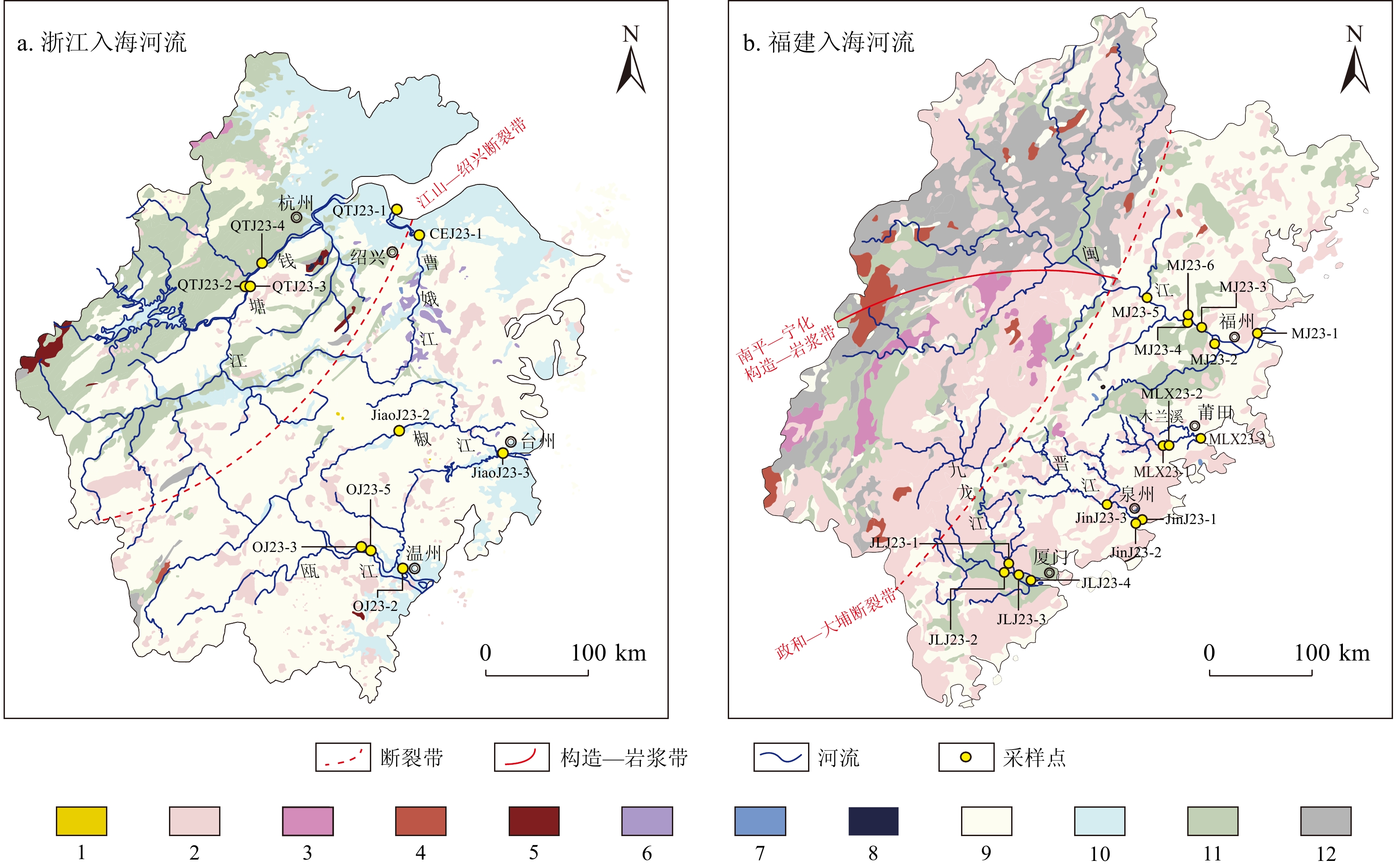
 下载:
下载:

